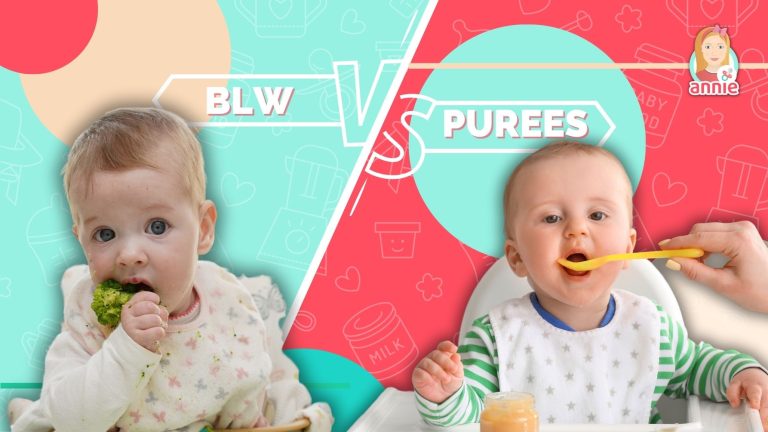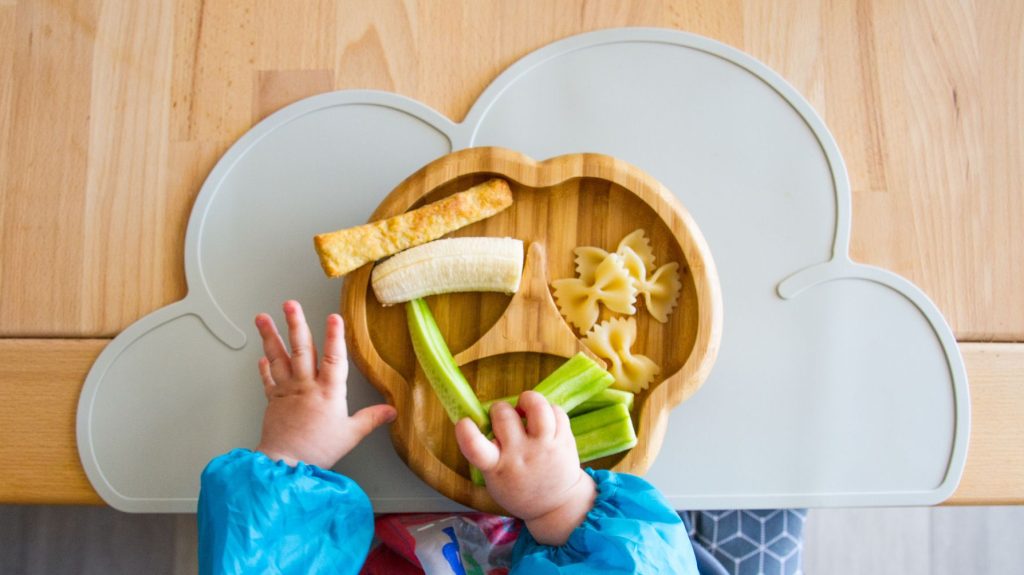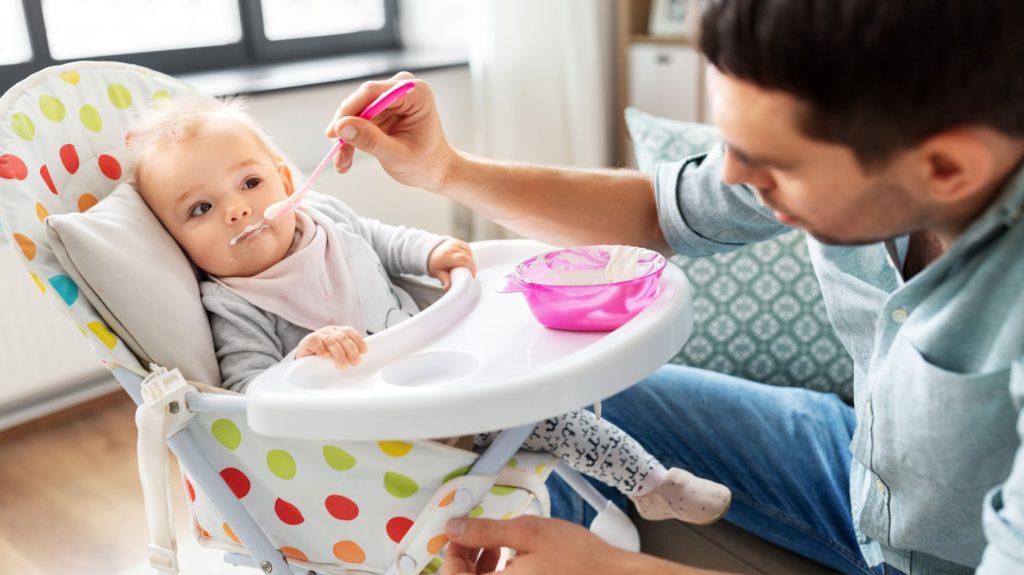
Baby Led Weaning vs Purees: Which Will Make Your Baby a Food Lover?
- Created:
27. 8. 2024 - Updated:
20. 8. 2024
Purees, baby-led weaning, or a mix of both?
There are many different weaning methods when it comes to starting solids, and there’s no one-size-fits-all approach.
Purees and baby-led weaning are the ones that get the most attention. Purees have been the traditional go-to for parents, but baby-led weaning (also known as BLW) has been gaining popularity since Gill Rapley introduced it in 2005.
If you’re not sure which feeding method to choose or if you just want to learn more about the differences, pros, and cons of each, keep reading.
I’ll guide you through the key things you need to know to decide on the best method for your baby.
What Are the Differences Between Baby Led Weaning vs Purees?
Let’s discuss the differences between BLW and traditional purees. It’s not just about the texture and appearance of the food but also about how it can affect your child’s development.
Baby Led Weaning vs Purees
| Baby-Led Weaning | Purees |
|---|---|
| the child gets to touch and eat solid foods at their own speed | spoon-feeding, where you decide how much and how fast they eat |
| holding, sucking, and chewing on big pieces of food, usually in stick or strip shapes | spoon-fed, mashed form |
| baby decide how they eat, which helps them develop a good sense of touch, taste, and smell, their hand-eye coordination, and fine motor skills | focus is mainly on swallowing and doesn’t give them much chance to explore their senses |
| a wider range of foods, different tastes and textures | food is usually more uniform and smooth |
| understand when they are hungry and when they are full, which could help them develop a healthier relationship with food | the child has no control over the quantity as is guided by you, thus does not have to understand fullness and hunger |
What age should Baby Led Weaning vs Purees be?
Experts, like the American Academy of Pediatrics (AAP), say it’s best to start introducing solids around 6 months of age, whether you’re doing baby-led weaning (BLW) or purees.
But keep in mind that it’s not just about the age—it’s more about whether your baby is showing the right signs. Look for things like being able to sit up on its own, not pushing food out with its tongue, and showing a real interest in eating.
If your baby is showing these signs, you can go ahead with BLW or purees, or even a mix of both.
Baby-Led Weaning: What You Need to Know
When it comes to feeding babies, baby-led weaning takes a different approach by skipping purees and encouraging self-feeding.
Let’s look at the good and not-so-good aspects of baby-led weaning.
👍 Pros of Baby-led Weaning
Baby-led weaning has a bunch of benefits.
This BLW feeding method primarily helps your little one develop self-feeding skills, improve hand-eye coordination, and improve chewing ability right from the start.
Plus, BLW exposes your little one to lots of different tastes and textures early on, getting them excited about food.
Also, BLW helps your child recognize when they are hungry and full, which will help them develop a healthier relationship with food.
Lastly, due to the shared mealtime experience—infants eating alongside family members—babies develop positive eating behaviours and reduce fussy eating tendencies, acquiring a sense of socializing.
👎 Cons of Baby-led Weaning
On the other hand, baby-led weaning has its downsides.
Firstly, there’s a higher risk of choking, especially if the food is not cooked well, too hard, or not cut properly.
Also, it takes a lot of time and patience because babies explore foods at their own pace. And let’s not forget the mess—when babies try to feed themselves, more food ends up on the floor than in their mouths.
Another thing is making sure your baby gets a balanced diet. Babies might only want to eat their favourite foods, which could mean they miss out on essential nutrients.
📖 Learn more about baby led weaning foods.

Purees: What You Need to Know
Looking ahead, let’s explore the benefits and drawbacks of using purees.
👍 Pros of Purees
Purees are a great way to make sure your baby gets all the good stuff they need. With each spoonful, they can get a mix of fruits, veggies, and grains, which covers all the important nutrients.
Plus, there’s less worry about choking, so you can relax a little.
Purees also make it easy to keep track of how much your baby is eating, which can help ease your mind.
Purees are also super convenient when you’re busy or on the go. You can make a bunch at once, heat them up quickly, and you’re good to go!
👎 Cons of Purees
On the flip side, purees also have their downsides.
For one, they don’t help babies develop chewing skills as early as baby-led weaning does because of the lack of texture.
Also, focusing on purees could limit a baby’s exposure to different flavours and food experiences, which might lead to picky eating habits later on.
Another thing to consider is that when you guide the child’s eating, they don’t learn to recognize their own fullness and hunger cues, which can lead to an unhealthy relationship with food.
Lastly, making purees takes a lot of effort. It involves cooking, pureeing, portioning, and storing foods, which can be time-consuming.
Additionally, parents who opt for store-bought purees must watch out for added sugars and preservatives, which aren’t great for a baby’s diet.
📖 Learn more about baby puree food combinations.

So, what is better for starting solids, baby-led weaning or traditional spoon feeding?
Choosing between baby led weaning vs purees when introducing solid food to your baby can be tough.
It’s important to remember that there isn’t one approach that fits everyone. What works best for you and your child depends on factors like your child’s readiness, your comfort level, family eating habits, and your daily schedule.
Baby-led weaning has advantages. It encourages self-feeding, exposes babies to various flavours, and promotes positive eating behaviours. However, it also has drawbacks, such as the risk of choking, the time commitment, the mess, and meeting nutritional needs.
On the other hand, traditional spoon feeding has its own benefits. It makes it easier to provide a balanced diet and is more convenient for busy parents. But it also has downsides, like potential delays in chewing development, limited taste exploration, and the time it takes to prepare purees.
Neither method is superior to the other. Each has its pros and cons, and the decision should be based on your child’s readiness, your preference, and your lifestyle. It’s about finding a balance and meeting individual needs. Both methods aim to help your child transition to solid food with ease and excitement, fostering a positive relationship with food.
How to Choose Between Baby Led Weaning vs Purees
When deciding between baby-led weaning and purees, it’s important to think about how ready and comfortable your child is with new foods.
Watch for signs like your baby showing interest in your meals and being able to sit up independently.
Also, pay attention to their reactions to different textures and flavours. It’s crucial to respect their responses as they communicate their comfort or discomfort.
Think about your family’s eating habits, too. Are your meals typically healthy? If not, purees might help you better control the nutrients.
Consider your daily schedule as well. Do you have time to monitor your baby closely during meal times? Baby-led weaning requires more direct supervision due to potential choking hazards. On the other hand, feeding purees might be more convenient for busy schedules. Although it limits your baby’s exposure to different food textures and flavours. Also, consider balanced nutrition.
While baby-led weaning can expose babies to diverse tastes and textures. It might be challenging to ensure nutritional balance in each meal. Purees allow you to control the ingredients and their quantities, making it easier to provide a balanced diet. But they can also lead to a limited assortment of flavours.
Above all, the key is to focus on your child’s positive engagement with food. It’s not about following a strict regimen; instead, mix and match methods if they suit your child best.
The Mix Method: Combination of Purees and Baby-Led Weaning
The mixed method, which includes feeding your little one with purees and baby-led weaning. Is a great way to ensure your child gets the best of both worlds.
It allows them to explore at their own pace while still getting all the nutrients they need. With the mixed method, both purees and baby-led weaning play an important role in helping your child get used to eating solid foods.
Among its benefits, the mixed method offers flexibility. It gives your little one the freedom to self-feed while still being introduced to different flavours and textures through purees, helping them expand their food preferences.
💡 For example, they can have some mashed potatoes (puree) and also try cooked carrot sticks (baby-led). The carrot provides necessary vitamins, while the potato gives them energy and keeps them full.
The mixed method also makes the transition to solid foods smoother for your child. Instead of making a sudden change, this approach gradually introduces new food textures.
💡 One fundamental tip is to pay attention to your baby’s cues to see which feeding styles they prefer. They might like to feed themselves at lunch but prefer purees at dinner.
Also, try giving purees when your baby is super hungry and encourage self-feeding when they are well-rested and curious.
And don’t forget to offer a variety of foods to ensure they get all the important nutrients. For example, you can give them pureed spinach for iron in the morning and soft-cooked apple for fibre in the afternoon.
Lastly, it’s important to become good at recognizing when your child is hungry or full. These cues are the signals kids use to show whether they’re hungry or happy with how much they’ve eaten. For instance, a child might reach for food when hungry or turn their head away when full.
Bottom line
So, baby led weaning vs purees?
You might lean towards baby-led weaning if you prioritize teaching your child independence from an early age. Baby-led weaning promotes self-feeding, where the child controls what, how much, and how quickly they eat. This method, backed by studies such as Blossfeld et al., 2007, can build a positive relationship with food and encourage healthy eating behaviours by offering a wider variety of textures and tastes. It, however, demands constant supervision to ensure child safety and adequate intake.
On the other hand, purees provide you with more control over nutrients and portion sizes your child consumes. Purees, often smoother and easier to tolerate, can make the transition less intimidating for your baby. Studies like Fewtrell et al., 2018, have shown that following a puree-based approach might reduce the risk of choking and ensure consistent nutrient intake. The drawback, though, lies in the limited exploration of food textures and the potential dependency on being fed.
However, it doesn’t necessarily have to be an either-or decision.
Using both purees and baby-led weaning can give you the best of both worlds. It lets your baby take their time, be more independent, and get all the good stuff they need.
Remember that mixing baby led weaning and purees can help make the switch to solid foods easier and help your little one develop a healthy relationship with food while getting all the nutrients they need.
FAQ: Baby Led Weaning vs Purees
Both puree and baby-led weaning have pros and cons. Mixing baby led weaning and purees can help make the switch to solid foods easier and help your little one develop a healthy relationship with food while getting all the nutrients they need.
Pediatricians have mixed opinions on baby-led weaning (BLW); while some support it as a safe and natural method for introducing solids to babies who are developmentally ready, others express concerns about choking risks and emphasize the importance of purees for ensuring adequate nutrition. Overall, recommendations can vary significantly among pediatricians, and parents are encouraged to choose the method that feels right for their child.
With baby-led weaning, you can skip purees and go straight to offering soft, finger-food sized pieces of table foods, allowing your baby to self-feed and explore different textures and flavors from the start of their solid food journey.
Yes, you can combine baby-led weaning and purees by offering both methods simultaneously, allowing your baby to explore self-feeding with finger foods while also receiving pureed foods for nutrition and variety. This hybrid approach can cater to your baby’s preferences and developmental needs.





